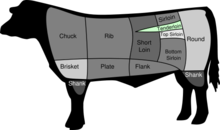Beef tenderloin

American beef cuts
|
|
| Type | Beef steak |
|---|---|
| |
|
A beef tenderloin, known as an eye fillet in Australasia, filet in France, the United Kingdom, South Africa and Germany, is cut from the loin of beef.
As with all quadrupeds, the tenderloin refers to the psoas major muscle ventral to the transverse processes of the lumbar vertebrae, near the kidneys.
The tenderloin is an oblong shape spanning two primal cuts: the short loin (called the sirloin in Commonwealth countries) and the sirloin (called the rump in Commonwealth countries). The tenderloin sits beneath the ribs, next to the backbone. It has two ends: the butt and the "tail". The smaller, pointed end—the "tail"—starts a little past the ribs, growing in thickness until it ends in the "sirloin" primal cut, which is closer to the butt of the cow. This muscle does very little work, so it is the most tender part of the beef. The tenderloin can be cut for either roasts or steaks.
Whole tenderloins are sold as either "unpeeled" (meaning the fat and silver skin remain), "peeled" (meaning that the fat is removed, but silver skin remains), or as PSMOs ("pismos"), which is short for peeled, silver skin removed, and side muscle (the "chain") left on. While the most expensive option pound-for-pound, PSMOs offer considerable savings over other tenderloin options as they require little handling by the chef, since the fat and trimmings have already been removed. Since it is the tenderest part of the animal, beef dishes requiring exceptionally tender meat, such as steak tartare, are ideally made from the tenderloin.
...
Wikipedia
